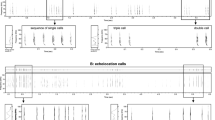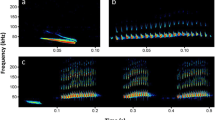Abstract
Contact calls are utilized by several bird and mammal species to maintain group cohesion and coordinate group movement. From a signal design perspective, contact calls typically exhibit acoustic features that make them easily localizable and encode information about individual or group identity. Pallid bats (Antrozous pallidus) are unusual among vespertilionids in that they often emit a loud, partially audible frequency-modulated social call several times in rapid succession while in flight. This call appears to function as a contact call in that it is frequently given when bats return from foraging and perform circular flights before entering a crevice roost. However, the degree to which pallid bats respond to the calls of conspecifics and what information is provided in the call is unknown. Thus, the goal of this study was to investigate pallid bat calling behavior to determine if calls attract roostmates or elicit responses from them and provide sufficient information for individual recognition. In playback studies, we found that contact calls, elicit calls, and approaches and that free-flying bats respond more to familiar than unfamiliar calls. In addition, analysis of frequency and temporal measurements of calls collected from multiple sites and spectral cross correlation analysis of calls recorded from the same radio-tagged bats on multiple evenings revealed that the frequency pattern of contact calls is highly repeatable over time within individuals but exhibits significant differences among individuals. Thus, contact call structure appears to be unique to individuals and stable through time, which makes these calls well-suited for roostmate recognition.




Similar content being viewed by others
References
Aldridge HDJN, Brigham RM (1988) Load carrying and maneuverability in an insectivorous bat—a test of the 5% “rule” of radio-telemetry. J Mammal 69(2):379–382
Altringham JD, Fenton MB (2003) Sensory ecology and communication in the Chiroptera. In: Kunz TH, Fenton MB (eds) Bat ecology. University of Chicago Press, Chicago, pp 90–127
Balcombe JP, McCracken GF (1992) Vocal recognition in Mexican free-tailed bats: do pups recognize mothers? Anim Behav 43:79–87
Barbour RW, Davis WH (1969) Bats of America. University Press of Kentucky, Lexington
Barlow KE, Jones G (1997) Function of pipistrelle social calls: field data and a playback experiment. Anim Behav 53:991–999
Beck AJ, Rudd RL (1960) Nursery colonies in the pallid bat. J Mammal 41:266–267
Beecher MD (1989) Signaling systems for individual recognition - an information-theory approach. Anim Behav 38:248–261
Blumstein DT, Daniel JC (2004) Yellow-bellied marmots discriminate between the alarm calls of individuals and are more responsive to calls from juveniles. Anim Behav 68:1257–1265
Blumstein DT, Munos O (2005) Individual, age and sex-specific information is contained in yellow-bellied marmot alarm calls. Anim Behav 69:353–361
Bohn KM, Moss CF, Wilkinson GS (2006) Correlated evolution between hearing sensitivity and social calls in bats. Biol Lett 2:561–564
Bohn KM, Schmidt-French B, Ma ST, Pollak GD (2008) Syllable acoustics, temporal patterns, and call composition vary with behavioral context in Mexican free-tailed bats. J Acoust Soc Am 124(3):1838–1848
Bohn KM, Wilkinson GS, Moss CF (2007) Discrimination of infant isolation calls by female greater spear-nosed bats, Phyllostomus hastatus. Anim Behav 73:423–432
Boughman JW (1998) Vocal learning by greater spear-nosed bats. Proc R Soc Lond B 265(1392):227–233
Bradbury JW, Vehrencamp SL (1998) Principles of animal communication. Sinauer Associates, Sunderland
Brown PE (1976) Vocal communication in pallid bat, Antrozous pallidus. Z Tierpsychol 41(1):34–54
Brown PE, Grinnell AD, Harrison JB (1978) Development of hearing in pallid bat, Antrozous pallidus. J Comp Physiol 126(2):169–182
Buhrman-Deever SC, Hobson EA, Hobson AD (2008) Individual recognition and selective response to contact calls in foraging brown-throated conures, Aratinga pertinax. Anim Behav 76:1715–1725
Carter GG, Skowronski MD, Faure PA, Fenton MB (2008) Antiphonal calling allows individual discrimination in white-winged vampire bats. Anim Behav 76:1343–1355
Chaverri G, Gillam EH, Vonhof MJ (2010) Social calls used by a leaf-roosting bat to signal location. Biol Lett 6(4):441–444
Clark CW, Marler P, Beeman K (1987) Quantitative analysis of animal vocal phonology: an application to swamp sparrow song. Ethology 76:101–115
Cortopassi KA, Bradbury JW (2006) Contact call diversity in wild orange-fronted parakeet pairs, Aratinga canicularis. Anim Behav 71:1141–1154
Couzin ID (2006) Behavioral ecology: social organization in fission-fusion societies. Curr Biol 16(5):169–171
Esser KH, Schmidt U (1989) Mother-infant communication in the lesser spear-nosed bat Phyllostomus discolor (Chiroptera, Phyllostomidae)—evidence for acoustic learning. Ethology 82(2):156–168
Falls JB (1992) Playback: a historical perspective. In: McGregor P (ed) Playback and studies of animal communication. Plenum, New York, pp 11–33
Fenton MB (1985) Communication in the Chiroptera. Indiana University Press, Bloomington
Fenton MB (2003) Eavesdropping on the echolocation and social calls of bats. Mamm Rev 33(3–4):193–204
Fenton MB, Jacobs DS, Richardson EJ, Taylor PJ, White E (2004) Individual signatures in the frequency-modulated sweep calls of African large-eared, free-tailed bats Otomops martiensseni (Chiroptera: Molossidae). J Zool (Lond) 262:11–19
Hamilton WD (1964) Genetical evolution of social behaviour. J Theor Biol 7(1):1–16
Hermanson JW, O'Shea TJ (1983) Antrozous pallidus. Mamm Species 213:1–8
Kanwal JS, Matsumura S, Ohlemiller K, Suga N (1994) Analysis of acoustic elements and syntax in communication sounds emitted by moustached bats. J Acoust Soc Am 96:1229–1254
Kazial KA, Burnett SC, Masters WM (2001) Individual and group variation in echolocation calls of big brown bats, Eptesicus fuscus (Chiroptera: Vespertilionidae). J Mammal 82(2):339–351
Kerth G (2008) Causes and consequences of sociality in bats. Bioscience 58(8):737–746
Kerth G, Mayer F, Konig B (2000) Mitochondrial DNA (mtDNA) reveals that female Bechstein’s bats live in closed societies. Mol Ecol 9(6):793–800
Krebs JR, Davies NB (1993) An introduction to behavioural ecology, 3rd edn. Blackwell, Cambridge
Lewis SE (1995) Roost fidelity of bats—a review. J Mammal 76(2):481–496
Lewis SE (1996) Low roost-site fidelity in pallid bats: associated factors and effect on group stability. Behav Ecol Sociobiol 39(5):335–344
Manley BFJ (1997) Randomization, bootstrap, and Monte Carlo methods in biology. Chapman & Hall, New York
McDonald PG, Heathcote CF, Clarke MF, Wright J, Kazem A (2007) Provisioning calls of the cooperatively breeding bell miner Manorina melanophrys encode sufficient information for individual discrimination. J Avian Biol 38(1):113–121
Nousek AE, Slater PJB, Wang C, Miller PJO (2006) The influence of social affiliation on individual vocal signatures of northern resident killer whales (Orcinus orca). Biol Lett 2(4):481–484
Orr RT (1954) Natural history of the pallid bat, Antrozous pallidus (leconte). Proc Calif Acad Sci 28:165–246
Pfalzer G, Kusch J (2003) Structure and variability of bat social calls: implications for specificity and individual recognition. J Zool (Lond) 261:21–33
Ramos-Fernandez G (2005) Vocal communication in a fission-fusion society: do spider monkeys stay in touch with close associates? Int J Primatol 26(5):1077–1092
Sayigh LS, Esch HC, Wells RS, Janik VM (2007) Facts about signature whistles of bottlenose dolphins, Tursiops truncatus. Anim Behav 74:1631–1642
Scherrer JA, Wilkinson GS (1993) Evening bat isolation calls provide evidence for heritable signatures. Anim Behav 46:847–860
Schoner CR, Schoner MG and Kerth G (2010) Similar is not the same: Social calls of conspecifics are more effective in attracting wild bats to day roost than those of other bat species. Behav Ecol Sociobiol doi:10.1007/s00265-010-1019-8
Siemers BM, Kerth G (2006) Do echolocation calls of wild colony-living Bechstein's bats (Myotis bechsteinii) provide individual-specific signatures? Behav Ecol Sociobiol 59(3):443–454
Tabachnick BG, Fidell LS (2001) Using multivariate statistics. Allyn and Bacon, Boston
Trivers RL (1971) The evolution of reciprocal altruism. Quart Rev Biol 46:35–37
Trune DR, Slobodchikoff CN (1976) Social effects of roosting on metabolism of pallid bat (Antrozous pallidus). J Mammal 57(4):656–663
Trune DR, Slobodchikoff CN (1978) Position of immatures in pallid bat clusters—case of reciprocal altruism. J Mammal 59(1):193–195
Tuttle MD, Stevenson D (1982) Growth and survival of bats. In: Kunz TH (ed) Ecology of bats. Plenum, New York, pp 105–150
Tyack PL (2003) Dolphins communicate about individual-specific social relationships. In: De Waal F, Tyack P (eds) Animal social complexity: intelligence, culture, and individualized societies. Harvard University Press, Cambridge, pp 342–361
Vaughan TA, O'Shea TJ (1976) Roosting ecology of pallid bat, Antrozous pallidus. J Mammal 57(1):19–42
Vehrencamp SL, Ritter AF, Keever M, Bradbury JW (2003) Responses to playback of local vs. distant contact calls in the orange-fronted conure, Aratinga canicularis. Ethology 109(1):37–54
Verts BJ, Carraway LN (1998) Land mammals of Oregon. University of California Press, Berkeley
Voigt-Heucke SL, Taborsky M, Dechmann DKN (2010) A dual function of echolocation: bats use echolocation calls to identify familiar and unfamiliar individuals. Anim Behav 80(1):59–67
Watwood SL, Owen ECG, Tyack PL, Wells RS (2005) Signature whistle use by temporarily restrained and free-swimming bottlenose dolphins, Tursiops truncatus. Anim Behav 69:1373–1386
Wilkinson GS (2003) Social and vocal complexity in bats. In: De Waal F, Tyack P (eds) Animal social complexity: intelligence, culture, and individualized societies. Harvard University Press, Cambridge, pp 322–341
Wilkinson GS, Boughman JW (1998) Social calls coordinate foraging in greater spear-nosed bats. Anim Behav 55:337–350
Wilkinson GS, Bradbury JW (1988) Radio telemetry: techniques and analysis. In: Kunz TH (ed) Ecological and behavioral methods for the study of bats. Smithsonian Institution Press, Washington, pp 105–124
Willis CKR, Brigham RM (2007) Social thermoregulation exerts more influence than microclimate on forest roost preferences by a cavity-dwelling bat. Behav Ecol Sociobiol 62(1):97–108
Acknowledgments
All field protocols were approved by the University of Maryland Institutional Animal Care and Use Committee (Protocol R-08-39). We would like to thank Emily Muns and Stephanie Rihl for assistance with field work, Tom Rodhouse for help with locating study sites, Kevin Misner for assisting with the videotape analysis, and Jason Douglas for help measuring calls. We are also grateful to the Confederated Tribes of Warm Springs and the National Park Service for allowing access to the field sites as well as the staff at Hancock Field Station in Clarno, Oregon for providing support during the field season. Finally, we would also like to thank Jackie Metheny, Beatrice Mao, Julie Samy, Genevieve Spanjer Wright, and two anonymous reviewers for comments that helped to improve the manuscript. This work was supported by research grants from Sigma Xi, the Cosmos Club Foundation of Washington DC, the American Society of Mammalogists, and the American Philosophical Society to B.D.A. as well as summer support provided by the BEES graduate program at the University of Maryland to B.D.A.
Author information
Authors and Affiliations
Corresponding author
Additional information
Communicated by G. Jones
Rights and permissions
About this article
Cite this article
Arnold, B.D., Wilkinson, G.S. Individual specific contact calls of pallid bats (Antrozous pallidus) attract conspecifics at roosting sites. Behav Ecol Sociobiol 65, 1581–1593 (2011). https://doi.org/10.1007/s00265-011-1168-4
Received:
Revised:
Accepted:
Published:
Issue Date:
DOI: https://doi.org/10.1007/s00265-011-1168-4




